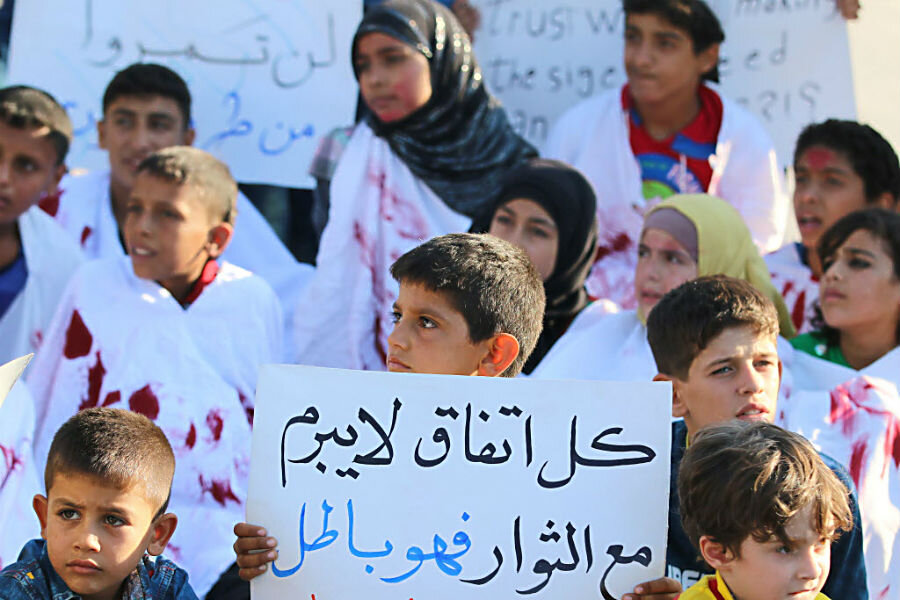Syria ceasefire: Will humanitarian aid reach people?
Loading...
Three days in to the seven-day cease-fire in Syria, the truce has accomplished at least one of its goals: no more civilian killings.
But, the United Nations has faced a number of other physical and political roadblocks to meet another goal: delivering aid to civilians.
The UN has been unable to drive about 20 delivery trucks loaded with food, medical items, and other necessities from the Turkish border to besieged zones in Syria including eastern Aleppo, Moadamiyah, al Waer, and Douma, according to Reuters. Obstacles that stand in their way include delays in the Syrian government providing permits to the convoy, and the demilitarization of Castello Road, the main road into besieged east Aleppo.
The difficulty the UN and others face delivering aid to civilians shows the complicated nature of providing relief from the conflict. While a temporary end to civilian violence is one accomplishment, another important step is providing Syrians with basic necessities. But, even that has become part of the war between regional and foreign powers, as Jan Egeland, secretary-general of the Norwegian Refugee Council and special adviser to the UN envoy, said Thursday.
"Can well-fed grown men please stop putting political, bureaucratic and procedural road blocks for brave humanitarian workers that are willing to go to serve women, children, wounded civilians in besieged and crossfire areas?" asked Mr. Egeland.
The deal brokered by the United States and Russia went into effect Monday evening. Although the full details of the agreement remain unclear, analysts have said it appears weighted in favor of the Assad regime and its Russian and Iranian allies rather than the Syrian opposition, reports Nicholas Blanford for The Christian Science Monitor.
One key detail of the agreement is the opening of channels across Syria for humanitarian access, as The Washington Post and other medial outlets have reported.
The delivery trucks are waiting in Turkey, loaded with food including rice, wheat, lentils, and sugar, as well as medical items, and other necessities for tens of thousands of people. But the trucks remain idle as the UN waits for the Syrian government to issue it permits.
"The government, I repeat the government, was expected to provide ... permits, authorizations," UN Special Envoy for Syria Staffan de Mistura told reporters in Geneva Thursday. They "have not been received," he added. The lack of permission was "a very major disappointment" even for Syria's ally Russia, Mr. de Mistura said.
Typically, vehicles are required to display permits at each armed checkpoint into besieged areas.
De Mistura said he was told offices were closed during Eid, the Muslim holiday this week, but he would not accept that as a valid reason.
Another obstruction to aid reaching Syrian civilians is the status of Castello Road, also known as “Death Road.” Syrian government and opposition forces would need to withdraw 1.9 miles (3 km) with their heavy weapons from the road in order for it to be demilitarized, according to Al Jazeera's Stefanie Dekker.
“The deal is that both want to do this at the same time because there is no trust," wrote Ms. Dekker.
The UN also worry a convoy could come under attack from militant factions that are outside the cease-fire pact, according to The Washington Post.
An outstanding question is whether the people of eastern Aleppo and other besieged parts of the country will even accept the food and aid. Nearly 300,000 civilians have been besieged in the eastern part of the city for a month. But a city councilor in Aleppo told the Los Angeles Times those people want freedom, not food.
"The people inside Aleppo don't want that aid," Brita Haji Hasan, head of the city council, said in an interview. "What's human about putting me in a cage and giving food to me?"
The weeklong ceasefire orchestrated by the US and Russia is also seen as a test of the trust between themselves and the Syrian groups they represent. If this works, the two have reportedly agreed to move forward with fighting terrorist groups such as self-declared Islamic state militants and Jabhat Fateh ash-Sham, formerly known as Al Qaeda-affiliated Jabhat al-Nusra, even though the extremist group is one of the most potent anti-Assad forces.
This report contains material from Reuters.







